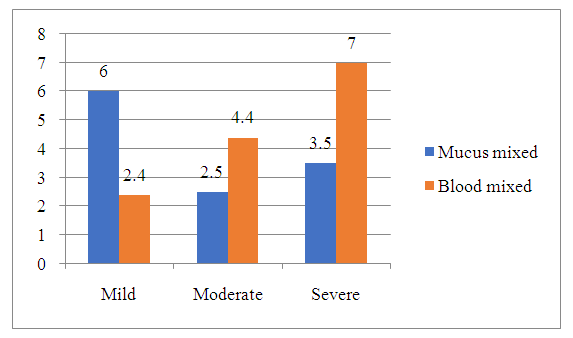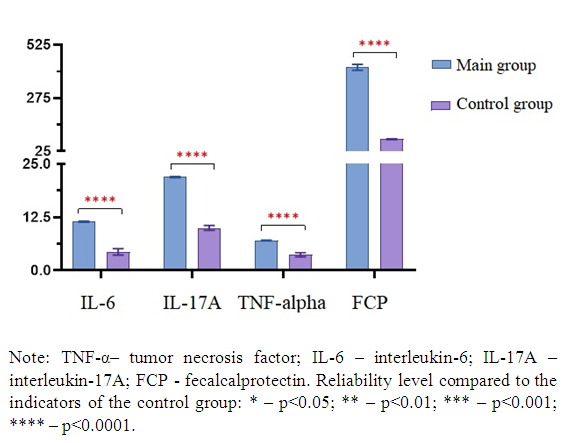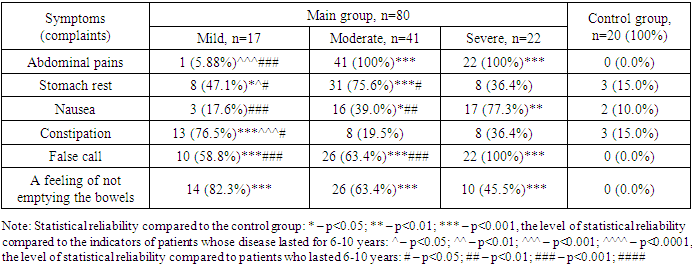-
Paper Information
- Next Paper
- Previous Paper
- Paper Submission
-
Journal Information
- About This Journal
- Editorial Board
- Current Issue
- Archive
- Author Guidelines
- Contact Us
American Journal of Medicine and Medical Sciences
p-ISSN: 2165-901X e-ISSN: 2165-9036
2024; 14(7): 1856-1858
doi:10.5923/j.ajmms.20241407.28
Received: Jun. 23, 2024; Accepted: Jul. 17, 2024; Published: Jul. 20, 2024

Significance of Cytokines in Assessing the Severity of Nonspecific Ulcerative Colitis
Ubaidova Dilafruz Saddikovna
Bukhara State Medical Institute named after Abu Ali ibn Sina, Bukhara, Uzbekistan
Correspondence to: Ubaidova Dilafruz Saddikovna, Bukhara State Medical Institute named after Abu Ali ibn Sina, Bukhara, Uzbekistan.
| Email: |  |
Copyright © 2024 The Author(s). Published by Scientific & Academic Publishing.
This work is licensed under the Creative Commons Attribution International License (CC BY).
http://creativecommons.org/licenses/by/4.0/

From 2021 to 2023, 80 patients with NUC who were examined and treated at the gastroenterology department of the Bukhara regional multidisciplinary medical center were included in the study. The average age of patients is 33.2 ± 0.8 years. The moderate degree of NUC prevailed over the mild and severe degree. In addition to clinical, laboratory and instrumental tests, patients underwent an immunological examination, IL-6, IL-17A, TNF-α and fecalcalcprotectin were examined. It was found that the amount of cytokines increases in accordance with the increasing severity of the disease.
Keywords: Nonspecific ulcerative colitis, Intestinal symptoms, Cytokines
Cite this paper: Ubaidova Dilafruz Saddikovna, Significance of Cytokines in Assessing the Severity of Nonspecific Ulcerative Colitis, American Journal of Medicine and Medical Sciences, Vol. 14 No. 7, 2024, pp. 1856-1858. doi: 10.5923/j.ajmms.20241407.28.
1. Introduction
- In the last decade, there has been an increase in inflammatory bowel diseases in gastroenterological patients, among which ulcerative colitis is predominant [4]. Nowadays, inflammatory bowel diseases are one of the most urgent problems of gastroenterology, and this disease is characterized by the uncertainty of its etiology, the complexity of its pathogenesis, frequent relapses, life-threatening complications, and lack of treatment [2]. Nonspecific ulcerative colitis (NUC or UC) is a chronic recurrent disease of the large intestine, which is a diffuse ulcerative inflammation of the mucous membrane of the large intestine, manifested by the development of local and systemic complications. The prevalence of UC is 26-268 among 100,000 inhabitants. The highest annual incidence of UC is found in Europe (24.3/100,000) and North America (19.2/100,000). Its frequency in these regions is 8-15 new cases per 100,000 population in 1 year, and the prevalence rate is 100,000. It corresponds to 80-120 people [3]. Currently, the following are considered the main pathogenetic causes of ulcerative colitis: genetic predisposition, disturbance of the protective function of intestines, disturbance of intestinal microflora and immune system [1]. The reasons for the change in the balance of cytokines in ulcerative colitis are still unknown, but according to assumptions, it is associated with an unusual immune response, persistence of one or more antigens, a violation of the relationship between the immune system of the intestinal mucosa and the intestinal microflora [5]. The purpose of the study is to improve the diagnostic methods of patients with ulcerative colitis by studying the relationship between the level of inflammatory cytokines in the serum of patients with ulcerative colitis and the severity of the inflammatory process in the colon.
2. Material and Methods
- In the study, the survey data of 80 patients with NUC examined and treated at the department of gastroenterology and proctology of the Bukhara Regional Multidisciplinary Medical Center from 2021 to 2023 were summarized. 20 healthy individuals were included in the control group. The average age of patients is 33.2 ± 0.8 years. Patients were divided into 3 age groups: 18-44 years (46 (57.5%)), 45-59 years old (24(30.0%)), 60-74 years old (10 (12.5%)). The proportion of men and women among patients with NUC, respectively 43 (53.75%), 37 (46.25%). Patients were divided into 3 groups according to severity: mild (n=16 (20%)1 patient, moderate (n=41 (51.2%) patient and severe (n=23 (28.7%) patient. Depending on the presentation of clinical symptoms, patients divided in predominantly diarrhea, tenism, abdominal bleeding, weight loss, abdominal pain form. Depending on the location of the process: distal (20%), left-sided (51%), total (29%) was divided into colitis. According to the course of the disease: acute 21 (26.2%), chronic continuous 10 (12.5%) and chronic recurrent 49 (61.2%) patients. All patients underwent a standard set of general clinical and biochemical laboratory tests: general blood analysis mainly (hemoglobin, leukocyte, erythrocyte, thrombocyte and ESR) indicators, blood biochemical analysis (urea, creatinine, ALT, AST, total protein, CRP, glucose) were checked. In addition, patients had their blood taken to check IL-6, IL-17A, TNF-α, and fecal calprotectin content was checked in their feces. EFGDS and colonoscopy, ultrasound examination of internal organs were performed.
3. Results and Analyses
- When analyzing the clinical symptoms depending on the severity of the disease, it was found that abdominal pain is mainly in the moderate and severe type, and differs from the mild type in that it is higher in the moderate type, and symptoms such as nausea, vomiting and false calls are more common in the moderate and severe type. However, in the mild type, patients with constipation prevailed (table 1).
|
 | Figure 1. The results of litter analysis according to the level of weight of the UC |
 | Figure 2. The results of inflammatory markers |
|
4. Conclusions
- Based on the results of our study, patients with NUC have serum levels of pro-inflammatory TNF-α, IL-6, IL-17A, calprotectin was determined. The results of immunoenzyme analysis showed the highest rate in the severe level of the disease, and a relatively lower rate in the moderate and mild levels.Therefore, as the levels of severity and activity levels of the disease increase, inflammatory markers (TNF-α, IL-6, IL-17A detected in blood serum and feces detected Calprotectin), the same result is the increase of inflammatory markers in the acute transitory type of the disease, and the opposite result was observed in the chronic continuous and chronic relapsing types.
 Abstract
Abstract Reference
Reference Full-Text PDF
Full-Text PDF Full-text HTML
Full-text HTML
